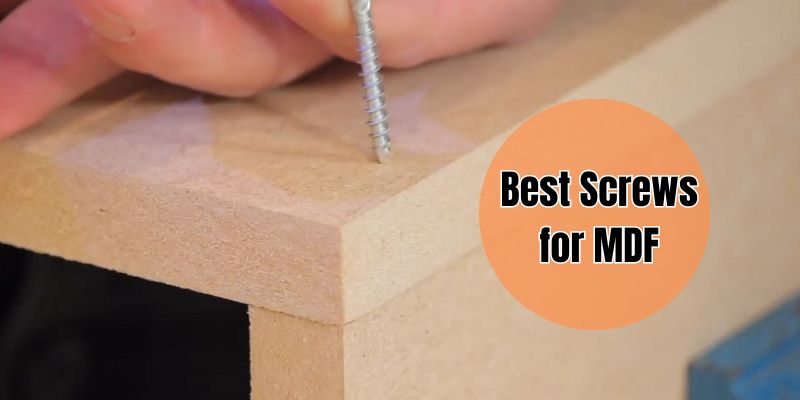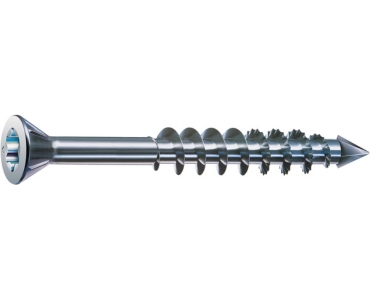Picking the right screws for Medium-Density Fiberboard (MDF) can make or break your woodworking project. MDF is a popular material for furniture and cabinetry, but it needs special care when it comes to fasteners. This guide will help you choose the best screws for MDF and show you how to use them correctly.

Understanding MDF and Its Fastening Requirements
MDF is made by compressing wood fibers with resin. It’s smooth, uniform, and great for painting, but it has some drawbacks. The main issue is that MDF doesn’t hold screws as well as solid wood. The face grain of MDF is denser than its core, which can make it tricky to fasten things securely.
When you’re working with MDF, you need to think about:
- The screw’s grip strength
- How likely the MDF is to split
- The screw’s ability to countersink smoothly
Choosing the wrong screws can lead to loose joints, visible screw heads, or damaged MDF. Let’s look at the best screw types for MDF to avoid these problems.
Top Screw Types for MDF
FASTENPOWER Coarse Thread Screws
Coarse thread screws are a top choice for MDF. Their wide, deep threads grip the MDF fibers better than fine thread screws. This gives them more holding power, which is key for keeping your MDF pieces together.
Read Here: Coarse Thread vs Fine Thread Screws
JQK Flat Head Phillips Wood Screw
JQK Flat Head Phillips Wood Screws are a reliable choice for MDF projects, especially for door hinges. These black screws are made from 18-8 stainless steel with an electroplated finish, offering good rust resistance. Their deep-cut Phillips drive helps prevent stripping, making them easier to install. For best results, pre-drill holes before using these 6 x 1/2-inch screws in your MDF.
SPAX MDF Countersunk Screws

SPAX MDF Countersunk Screws are made just for MDF. They have a special thread design that cuts into the MDF without pushing the fibers apart. This reduces the risk of splitting and gives a strong hold. These screws also have a small point that helps them start easily without needing a pilot hole.
HighPoint Euro Cabinet Screws
Euro Cabinet Screws are great for joining MDF panels. They have a large, flat head that spreads the load over a bigger area. This stops the screw from pulling through the MDF. Euro Cabinet Screws work well with euro-style hinges and other hardware.
Brand Comparisons
Now let’s look at some popular screw brands for MDF:
FASTENPOWER
FASTENPOWER offers coarse thread screws that work well with MDF. Their screws have wide, deep threads that grip MDF fibers tightly. This brand is known for making screws that hold MDF pieces together firmly. FASTENPOWER screws are a good choice for many types of MDF projects.
JQK
JQK makes flat head Phillips wood screws that are useful for MDF work. Their screws are made of stainless steel with a black coating to fight rust. JQK screws have a deep Phillips head to reduce stripping. They’re especially good for attaching hinges to MDF doors. JQK recommends pre-drilling holes for best results.
SPAX
SPAX creates screws made just for MDF. Their screws have a special thread design that cuts into MDF without pushing the fibers apart. This helps prevent splitting. SPAX screws also have a small point that lets them start in MDF without a pilot hole. This brand focuses on making screws that work well with MDF’s unique properties.
HighPoint
HighPoint produces Euro cabinet screws that are great for MDF panel joining. Their screws have a large, flat head that spreads pressure over a wider area. This design helps stop screws from pulling through the MDF. HighPoint screws are particularly useful for attaching cabinet hardware to MDF.
Each brand has its strong points. Your choice will depend on your specific MDF project needs.
Unbranded Screws
Unbranded screws can be hit or miss with MDF. Some work well, while others may not have the right features for MDF. If you use unbranded screws, look for ones with coarse threads and a countersunk head.
Screw Performance Testing
To find the best screws for MDF, we need to look at how they perform in tests:
Axial Load Test
An axial load test measures how much force a screw can take along its length before it pulls out of the MDF. In these tests, coarse thread screws and screws made for MDF (like SPAX) usually do best. They can hold more weight before failing.
Shear Load Test
The shear load test checks how much sideways force a screw can handle before it breaks or tears out of the MDF. Euro Cabinet Screws often do well in this test because of their large head size.
Pull-out Resistance
Pull-out resistance is how hard it is to pull a screw straight out of the MDF. Screws with wide, deep threads (like coarse thread screws) tend to have the best pull-out resistance in MDF.
Best Screws for Specific MDF Applications
Different MDF projects need different types of screws. Here are some common applications and the best screws for each:
Euro Hinges Installation
For attaching euro hinges to MDF cabinet doors, use Euro Cabinet Screws. Their wide head gives good support to the hinge plate. If the MDF is thin, you might need to add a wood block behind the hinge for extra strength.
Attaching Brackets
When fixing brackets to MDF shelves or furniture, use coarse thread screws. They’ll give a strong hold without splitting the MDF. Make sure the screw length doesn’t go all the way through the MDF.
Securing Drawer Runners
For drawer runners, you need screws that won’t work loose over time. SPAX MDF screws or other specialized MDF screws work well here. Their thread design helps them stay put even with the repeated movement of drawers.
Proper Installation Techniques
Using the right screws is only part of the job. You also need to install them correctly:
Importance of Pilot Holes
Always drill pilot holes in MDF before inserting screws. This stops the MDF from splitting and makes it easier to drive the screws. For best results, make your pilot hole about 90% of the screw’s core diameter.
Using Solvent-Based Glue for Reinforcement
Adding a drop of solvent-based glue to the pilot hole before inserting the screw can make the joint stronger. The glue soaks into the MDF fibers and hardens, creating a more solid base for the screw.
Combining Screws with Brad Nails
For extra strength, you can use both screws and brad nails. First, join the pieces with brad nails to hold them in place. Then add screws for long-term strength. This works well for attaching MDF backs to cabinets or joining large panels.
Alternative Fastening Methods
While screws are often the best choice for MDF, there are other options:
Brad Nails
Brad nails are quick and easy to use. They don’t split the MDF and leave tiny holes that are easy to fill. However, they don’t have the holding power of screws. Brad nails are best for light-duty jobs or for holding pieces in place while glue dries.
Specialized MDF Fasteners
There are special fasteners made just for MDF. These include expanding bolts, plastic inserts, and cam locks. These can be useful for furniture that needs to be taken apart and put back together often.
Tips for Successful MDF Screw Installation
Here are some extra tips to help you get the best results when using screws in MDF:
Avoiding Splits and Blow-Outs
To avoid splitting the MDF, don’t put screws too close to the edges. A good rule is to keep screws at least 1 inch from the edge of the board. If you must put a screw near an edge, drill a pilot hole and work slowly.
Proper Screw Depth
Don’t over-tighten screws in MDF. Stop when the screw head is just flush with the surface. Over-tightening can strip out the MDF and weaken the joint.
Tools and Accessories for Easier Installation
Using the right tools can make working with MDF much easier:
- A countersink bit helps create the right shape hole for countersunk screws.
- A depth-stop collar on your drill bit ensures you don’t drill pilot holes too deep.
- A screw gun with adjustable torque lets you drive screws to the right depth every time.
Wrapping Up
Choosing the best screws for MDF doesn’t have to be hard. Remember these key points:
- Use coarse thread screws for better grip.
- Countersunk screws give a clean look.
- Specialized MDF screws like SPAX can make your job easier.
- Always drill pilot holes.
- Don’t over-tighten screws in MDF.
With the right screws and techniques, you can create strong, long-lasting MDF projects. Happy building!
Frequently Asked Questions
Can I use regular wood screws in MDF?
You can, but it’s not ideal. Regular wood screws often don’t grip MDF well and can easily strip out. Coarse thread screws or screws made for MDF are much better choices.
How do I choose the right screw length for MDF projects?
Your screw should go about two-thirds of the way into the second piece of MDF. For example, if you’re joining two 3/4 inch MDF pieces, use a screw that’s about 1 inch long.
Are there any waterproof screws suitable for MDF in humid environments?
While no screw is truly waterproof, screws with a zinc coating (like Screwfix TurboGold) resist rust well. For very damp areas, stainless steel screws are even better.
What’s the difference between particle board screws and MDF screws?
MDF screws usually have deeper, sharper threads than particle board screws. This helps them grip the dense fibers of MDF better. However, many screws work well in both materials.
How often should I replace screws in MDF furniture?
If installed correctly, screws in MDF furniture shouldn’t need replacing unless the furniture is damaged or the screws come loose. Check screws yearly and tighten any that have worked loose.


